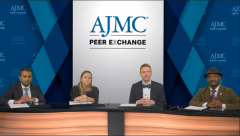
Front-line Treatment Management for Patients with Multiple Myeloma (MM)
Key opinion leaders open a discussion surrounding the current treatment landscape of multiple myeloma (MM).
Episodes in this series

Ryan Haumschild, PharmD, MS, MBA: Hello and welcome to this American Journal of Managed Care®peer exchange: Utilizing pathway-directed therapy and multiple myeloma. My name is Dr Ryan Haumschild, director of Pharmacy Services at Emory Healthcare and Winship Cancer Institute [in Atlanta, Georgia]. Joining me today in this live discussion are Dr Omar Nadeem, medical oncologist, clinical director of the Myeloma Immune Effector Cell Therapy Program and Clinical Director of the Center for Prevention of Progression at Dana-Farber Cancer Institute [Boston, Massachusetts], and Instructor in Medicine, Harvard Medical School [Boston, Massachusetts]; Dr Raymond Thertulien, system director, multiple myeloma and plasma cell disorders at Novant Health Weisiger Cancer Institute [Charlotte, North Carolina]; and Dr Brea Lipe, clinical director of Wilmot’s [James P. Wilmot Cancer Center] multiple myeloma program [Rochester, New York] and professor with the University of Rochester Medical Center Department of Medicine. Today we’re going to talk about several topics pertaining to multiple myeloma, including discussions around the treatment landscape in the frontline clinical setting and clinical pathways in oncology. Let’s get started. Let’s first talk about the treatment landscape in frontline multiple myeloma. Dr Nadeem, we can start with you. Could you give everyone an overview and briefly review the available frontline treatment options for patients with transplant-ineligible multiple myeloma?
Omar Nadeem, MD: Thanks, Ryan. As we’re all aware, the average age of diagnosis for patients with newly diagnosed multiple myeloma is around 70 years…. With that, naturally, a lot of patients will have medical conditions and comorbidities; hence, they will not be able to tolerate high-dose chemotherapy and stem cell transplant. We’re lucky in the field that numerous advances have occurred with new approvals and that these therapies are so well tolerated in patients, particularly the older patients. The 2 main regimens that come into play for the transplant-ineligible patients are 1) lenalidomide + bortezomib + dexamethasone [RVd], or 2) daratumumab + lenalidomide + dexamethasone. Both of these are fairly commonly used triplets in patients with transplant-ineligible myeloma. We’ll go over some of the data shortly about the pros and cons of each approach, but it’s safe to say that it’s nice to have these options, and they do differ in their efficacy and toxicity profiles to some extent, which helps with decision-making for individual patients.
Ryan Haumschild, PharmD, MS, MBA: Thanks for giving us that overview, because I think the difference of having anti-CD38 in that combination of frontline regimen and having multiple options for patients is always a good thing.
Transcript edited for clarity.
Newsletter
Stay ahead of policy, cost, and value—subscribe to AJMC for expert insights at the intersection of clinical care and health economics.








































